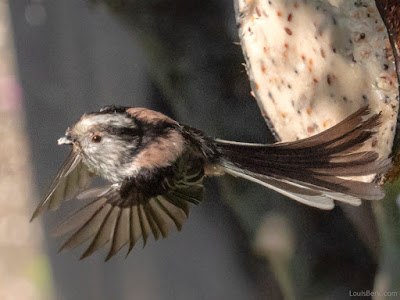 |
| In Flight - Long Tailed Tit |
A few weeks ago I observed they were doing circuits around the local gardens. They would shoot over to a nearby holly tree. Then they would make for a large Ceanothus bush at the front of our garden - very close to a major road. They would disappear inside and then suddenly shoot out of the top of the bush.
 |
| Caught shooting out of the top of the Ceanothus bush in my garden. |
 |
| Unfurling their wings before turning around and making off |
Now I am no expert on bird behaviour and while it was great fun to see and a terrific challenge to capture I finally worked out what was going on.
 |
| Beak full of caterpillar |
The tiny birds were collecting insects from the leaves of the holly tree and taking them to their nest situated within the Ceanothus. It became clear there were a pair birds feeding their young.
The photography of such tiny birds moving at high speeds is challenging. It requires a camera with blazing fast autofocus, a sensor with a large megapixel count - for cropping, and a fast and sharp lens. Fortunately, my camera lens combination is the superb Panasonic Lumix G9 with the Lumix Leica DG 200/2.8 telephoto prime lens. In addition I also used a 1.4x teleconverter to increase the effective focal length of the lens to 280mm. The G9 sensor has a 'crop' factor of 2x which means that I am really working at an equivalent focal length of 560mm at an aperture of f4. All this in a bundle which weighs about 2Kg - which compared to more traditional wildlife rigs is lightweight.
A key requirement is fast shooting speeds at low iso and the f4 aperture meant I was able to achieve 1/6400 shutter speeds while keeping my effective sensor speed down to iso1000, although at times it did peak up to iso2500. Fortunately, the sensor noise is still fairly low at these speeds and in post processing, my preferred RAW converter - Lightroom 6 - does a good job of noise reduction.
 |
| Almost as fast as a speeding bullet |
These really are beautiful birds. I hope whereever you are located at present this spring time (rapidly now becoming summer!) you are also enjoying the wonders of natural wildlife - one of life's great pleasures.







































